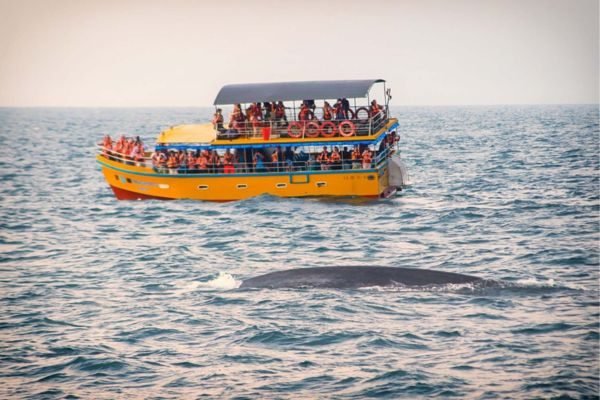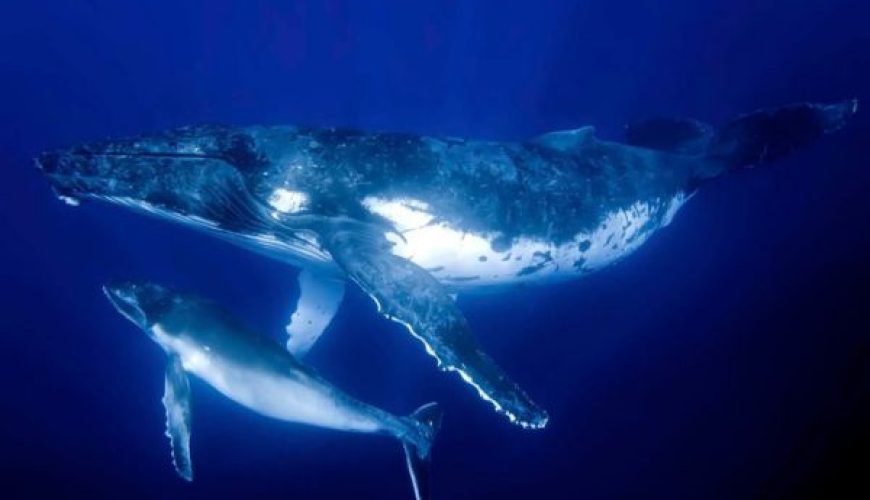Whale Watching in Sri Lanka
Why choose Sri Lanka?
Sri Lanka stands out as a treasure trove of biodiversity, securing its status as one of Asia’s premier wildlife sanctuaries and a significant player on the global stage. Imagine encountering majestic elephants as they roam freely in Uda Walawe National Park, observing vibrant birds in the lush canopies of Sinharaja Forest Reserve, and even spotting elusive sloth bears in the expansive Wilpattu National Park. But the wonders of Sri Lanka extend beyond the land.
“Most whale photos you see show whales in this beautiful blue water—it’s almost like space”
Brian Skerry
Surrounded by the Indian Ocean, this island nation teems with an impressive array of marine life. Its waters are home to both mugger and formidable saltwater crocodiles, graceful green and leatherback turtles, as well as diverse dolphin species including spinner, Risso, and bottlenose. Not to mention, the waters around Sri Lanka are a haven for whale watching, hosting species like the majestic blue, sperm, humpback, and Bryde’s whales.
Embarking on a whale-watching tour in Sri Lanka is not just a possibility but a journey into one of the world’s top whale-watching destinations. Thanks to the abundant krill, these giants of the ocean thrive here. Additionally, the island is a critical waypoint in the annual migration of blue and sperm whales—a phenomenon first charted by British marine biologist Charles Anderson in 1999. This migration, passing between the Bay of Bengal and the Arabian Sea along Sri Lanka’s coasts, is celebrated as one of the most spectacular cetacean migrations globally.
Discover the best spots in Sri Lanka for an unforgettable whale-watching experience and immerse yourself in the natural beauty of one of the planet’s most incredible wildlife arenas.
Whale watching in Mirissa – South Coast

Mirissa is the premier destination for whale watching in Sri Lanka, boasting a 90% sighting success rate during peak season, coupled with well-established tourist facilities. This charming coastal village, nestled on the southern coast between Galle and Matara, is a magnet for both whale watchers and beach enthusiasts from around the globe.
Getting There: Mirissa is conveniently located about a 40-minute drive from Galle, a picturesque beach destination known for the UNESCO World Heritage Site, Galle Fort. From Colombo, the capital city and the main entry point to Sri Lanka, it’s approximately a 4-hour drive.
What to Expect: Whale watching tours usually kick off early at 6:30 AM. Depending on the day’s weather and sea conditions, the trip duration can vary, typically lasting between 3 to 5 hours, with 40 minutes to 1 hour dedicated to whale watching.
Accommodations: Due to the early morning start of whale watching tours, it’s advisable to stay overnight in Mirissa. The area offers a wide range of hotels, catering to various preferences and budgets. Alternatively, some visitors choose to stay in Galle, approximately 30-40 minutes away by car, and travel to Mirissa early in the morning.
Local Geography and Wildlife: Mirissa’s prime location near the narrowest point of the continental shelf, where the ocean depth can reach up to 1km just a few kilometers offshore, creates an ideal habitat for whales. This geographic feature enhances your chances of encountering these magnificent creatures.
Tour Options:
Numerous operators, primarily based out of Mirissa Harbour, offer whale and dolphin watching tours from Weligama Bay. While some operators run smaller boats accommodating around eight guests, others operate larger vessels that can host over fifty people. Although tours typically start at 6 AM and last about 3 to 4 hours, choosing a reputable tour operator is crucial for ensuring a safe and environmentally responsible experience.
Best Time to Visit: The optimal period for whale watching in Mirissa is from December to April, when the sea conditions are most favorable for sightings.
Mirissa isn’t just the best place for whale watching in Sri Lanka; it’s a picturesque escape that offers a blend of thrilling wildlife encounters and serene beach relaxation.
Whale watching in Kalpitiya – North western Coast

Kalpitiya, located on the northwestern coast of Sri Lanka just north of Chilaw, is not only known for its rich history and beautiful beaches but has also emerged as a fantastic whale-watching spot over the past decade. This area is particularly noted for its sperm whale sightings, as these giants dive deep to hunt for giant squid. On occasion, lucky visitors might also catch a glimpse of the elusive blue whale.
Accommodations and Tours: The region boasts a variety of lodging options, from hotels to camps and guesthouses, all of which typically offer assistance in arranging whale-watching excursions for their guests. These tours generally begin at sunrise to take advantage of the calm morning waters and usually last about three hours.
Optimal Season for Visits: The best period to engage in whale watching in Kalpitiya is from November to March or April, avoiding the monsoon season to ensure that the sea conditions are ideal for a pleasant and safe boat ride.
Local Attractions: Besides whale watching, Kalpitiya is renowned for its scenic lagoons and historic sites, offering a perfect blend of natural beauty and cultural heritage. This makes it an excellent destination for those looking to combine wildlife observation with a relaxing beach vacation and some historical exploration.
Marine Life and Ecological Importance: Kalpitiya’s waters are teeming with marine life, making them a significant area for biodiversity and conservation efforts. The presence of both sperm and blue whales highlights the ecological richness of the area, attracting not only tourists but also researchers and nature enthusiasts.
Visiting Kalpitiya provides a unique opportunity to witness some of the ocean’s most majestic creatures in their natural habitat while enjoying the tranquil beauty of one of Sri Lanka’s less commercialized coastal areas.
Best time to visit: November–March/April
Whale watching in Trincomalee – Estern Coast

The east of Sri Lanka is flanked with sandy beaches, soothing coastal scenery and a maze of waterways. While it’s generally quieter than near Colombo, there’s plenty on offer. Arugam Bay is a world-class hotspot for surfers, and if you keep your eyes peeled in Lahugala National Park, you might even spot a few elephants, too.
Trincomalee: A Premier Whale Watching Destination in Sri Lanka
Trincomalee, located on the northeastern coast of Sri Lanka, is renowned for its deep natural harbor, one of the deepest in the world. This strategic geographic feature makes it an ideal location for whale watching, particularly for spotting blue and sperm whales. These majestic creatures are often seen here as they come to mate, with sightings most frequent from June to October.
Accessibility: Trincomalee is approximately a 2-hour drive from the ancient city of Sigiriya, known for its iconic Lion Rock. This proximity makes it a convenient addition to a cultural tour of Sri Lanka.
Whale Watching Tours:
Whale watching tours typically depart early from Trincomalee Harbor, around 6 a.m. or 7 a.m. The journey to the whale watching sites takes about 30 minutes by boat, during which there is a high chance (90%) of encountering blue whales, dolphins, and turtles. Depending on your schedule and interest, you can choose from various tour lengths—short harbor cruises lasting an hour, standard cruises of about three hours, or extended cruises that last five hours.
Local Highlights and Activities:
Despite its less developed infrastructure compared to more tourist-heavy areas like Mirissa and Kalpitiya, Trincomalee offers a charming, less commercialized experience. For those who prefer to stay on land, Swami Rock offers excellent vantage points for whale watching from the shore. This steep cliff provides panoramic views of the ocean and is a perfect spot to watch whales breaching the surface.
Just a kilometer off the coast near the village of Nilaveli is Pigeon Island National Park, a haven for snorkelers. The park is home to vibrant coral reefs and a plethora of tropical fish. Tours to the island give visitors a chance to swim with turtles and, occasionally, whales.
Best Time to Visit: The ideal time to visit Trincomalee for whale watching is between March/April and August/September, when the seas are typically calmer, making it easier to spot whales and enjoy the boat trips.
Trincomalee’s combination of significant historical sites, stunning natural beauty, and exceptional opportunities for marine wildlife observation makes it a unique and rewarding destination for travelers seeking a blend of culture and adventure in Sri Lanka.
Tips for Whale Watching in Sri Lanka
When planning a whale watching trip in Sri Lanka, here are some essential tips to ensure a comfortable and memorable experience:
Hydration and Nutrition: Carry your own water and light snacks to stay hydrated and energized during the trip. While some boats might offer a simple breakfast and drinking water, it’s always best to come prepared.
Rest Well: Avoid consuming alcohol the night before your trip. A good night’s sleep will help you stay alert and enjoy the experience more fully the next day.
Manage Seasickness: If you are prone to seasickness, take preventative medication about 1-2 hours before boarding the boat. It’s also a good idea to bring extra pills with you, just in case. Seasickness pills are readily available at pharmacies throughout Sri Lanka.
Camera Preparedness: Charge your camera the night before and consider bringing spare batteries. You’ll want to capture as many moments as possible, and having a fully charged camera and backups is crucial.
Dress Appropriately: Although it might be warm on land, the sea breeze can be chilly. Bring a coat or jacket to stay warm while out on the water.
Sun Protection: The sun can be intense out at sea. Remember to bring sunglasses, a hat, and sufficient sun cream to protect yourself from UV rays.
Following these tips will help you have a more enjoyable whale watching tour, allowing you to focus on the incredible sights and experiences that await in the waters of Sri Lanka.







0 Comment